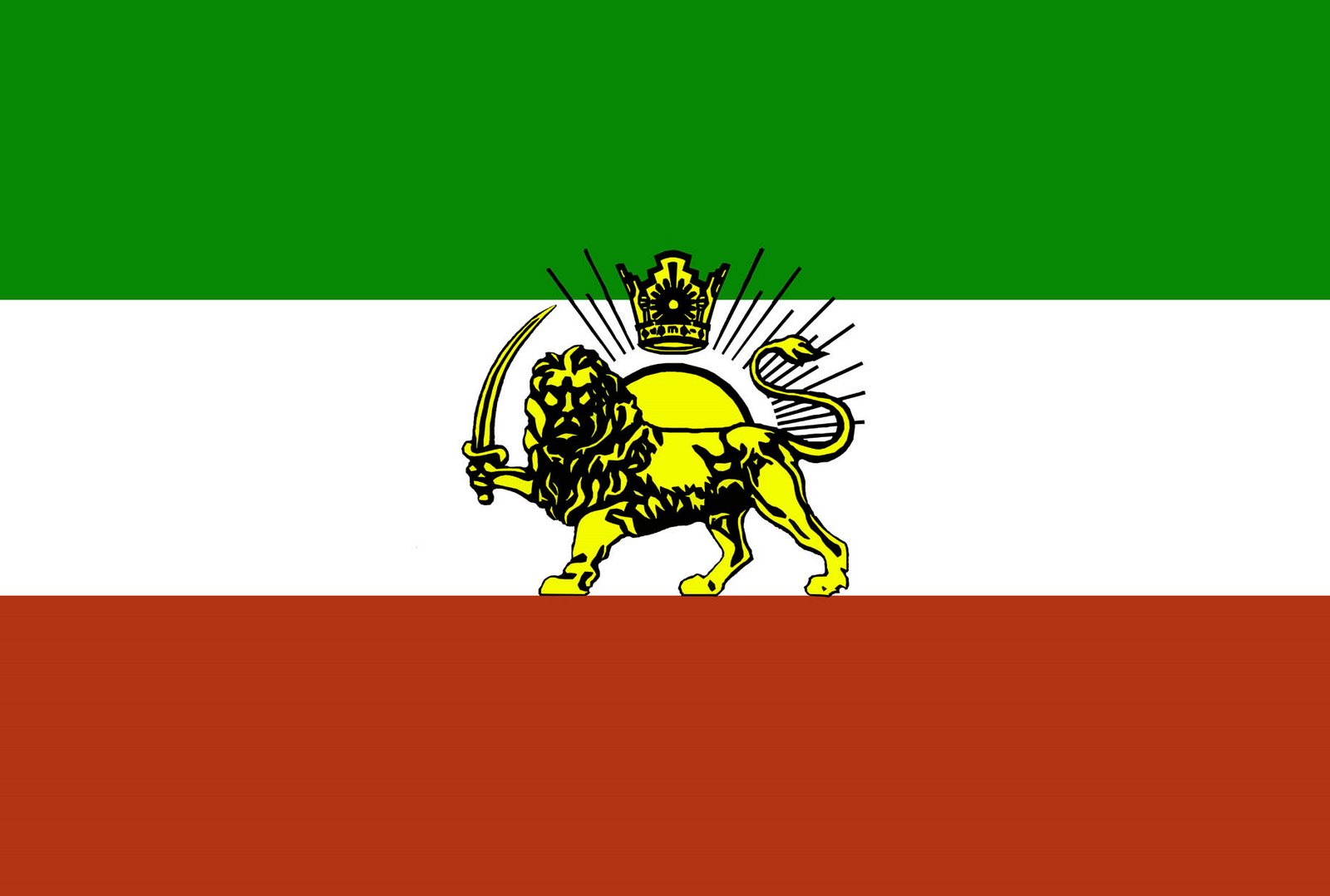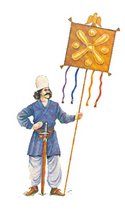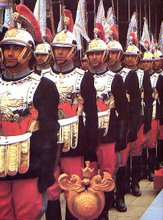Tuesday, July 31, 2007
Shahanshah Aryamehr - President Nixon - White House
CLIP
God bless His Imperial Majesty and his noble aspirations not only for his own country but for the entire world.
Sunday, July 29, 2007
Pasho Pasho
A video which urges Iranians to rise up against the filthy anti-Iranian mullah's who have been occupying Iran through terror and executions since their coming to power in the coup d'ètat of 1979.
Saturday, July 28, 2007
Comments in persian script
Friday, July 27, 2007
Shahanshah Aryamehr - July 27 - Cairo - Egypt

Her Imperial Majesty the Empress of Iran at the site of her husband's temporary tomb - Shahanshah Aryamehr; Cairo, Egypt, July 2007. HIM the Empress also paid tribute to the memory of President Anwar Sadat who was the only head of state that stood by the Shah and remained a true friend of the Iranian Nation as the international community (Europe/U.S.) went ahead with their plans to establish chaos and anarchy in Iran through the establishment of a "green belt" policy.
To hear HIM the Empress' message on this occasion in Cairo CLICK HERE.
To read a statement by HIM the Empress please CLICK HERE.
Ravaneh aan do Abarmardeh Iranparaste Irani, Shahanshahane Pahlavi, Shaad Baad.
Wednesday, July 25, 2007
Persian not Farsi!

Persian NOT Farsi
Iranian Identity Under Fire: An Argument Against
the Use of the Word ‘Farsi’ for the Persian Language
Shapour Suren-Pahlav
02 July 2007
Abridged version: 06 July 2007
The term Persian has been used in the English language for over five hundred years: to describe both a nation with 7000 years of archaeological history, and also the language that nation has used since the rise of the first Persian Empire, the Achaemenids.
Unfortunately however, the word ‘Farsi’ is increasingly and incorrectly being used to describe the Persian language. This paper outlines the linguistic and cultural context of Persian, as well as exploring the potential motivations of those promoting the incorrect usage of the word ‘Farsi’.
It explains clearly how the use of the word ‘Farsi’ instead of Persian voids important historical and cultural associations for the Iranian nation, with its long history of civilisation, and how it can therefore be seen as an insult to the heritage of Iran.
LINGUISTICS
New Persian or Persian for short is described linguistically as an Indo-European language. It is categorised as one of the Modern Iranian languages, along with Kurdish, Baluchi, Pashto, Ossetic and number of other languages. It is a member of the Western Iranian branch of the Iranian languages, which are themselves a subgroup of the Indo-Iranian (or Indo-Aryan) family of languages. As such, Persian is distantly related to the vast majority of European languages, including English.
Over the past three millennia, Persian has developed through three distinct stages of Old, Middle and New. New Persian is a successor to, and derived from Middle Persian, and can be considered as having two phases: classical and modern – although both variants are mutually intelligible[1].
The period after the Islamic conquest is described by Iranian scholars as the ‘Two Centuries of Silence’. There is no inscriptional or textual evidence for New Persian and only very scanty indications for the continuing use of Middle Persian. However scholars consider it unlikely that Iranians deserted their mother tongue and only cultivated Arabic[2]. The lack of any literary evidence from this period will certainly have been compounded by the destruction of Iranian libraries by the Mongols under Genghis Khan and his successors – and there may also be other reasons unknown to us[3].
The subsequent ‘Persian renaissance’ was marked by the advent of Classical Persian. This emerged in Khorasan in eastern Iran[4] and so was strongly influenced by Eastern-Iranian linguistic elements[5]. Arabic also had a major impact: with large numbers of loanwords, increasing palatalisation and also the inclusion of some grammatical elements. A modified version of Arabic script was adopted and some letter changes were made. For the purposes of this paper, the most important of these was the use of /F/ for /P/. As Arabic has no /p/ phoneme, the area of Pārs, the Iranian people who originated there and their language came to be described by natives as ‘Fārs’ and ‘Fārsi’.
After these linguistic changes, Persian then remained essentially unchanged until the nineteenth century. At that time, what is now called Modern or Standard Persian developed from the Tehrani vernacular – following the adoption of Tehran as the capital city of Iran by the Qajar s in 1787.
NOMENCLATURE
The name Persian derives from the province of Pārs (modern Fārs) in southwestern Iran. This was itself named after the Persian tribes of Indo-European nomads who migrated, along with some other Iranian peoples, from territories east of the Caspian Sea onto the Iranian plateau in the middle[6] or later part of the second millennium BCE[7].
The Persians settled in the mountain country rising over the northeast side of the Persian Gulf and enclosing the high basin in the west in which Persepolis and Shiraz are situated[8], some time between the seventh and ninth centuries BCE[9]. The name survived as Fārs[10]. This region then became the birthplace of two Persian dynastic empires – the Achaemenids (550-530 BCE) and the Sasanids (224-651CE) – as well as the cradle of the Persian language.
Achaemenid Persians called their language (Old Persian) Pārsa and the Greeks followed this in naming it Persis. From then on, other nations have predominantly named Persia and Persian using words based on the root Pārs-[11].
For example, the English use of the word ‘Persian’ has a five hundred year history[12] and is derived from the Latin Persianus, itself drawing on the Greek Persis. Similarly, the French word is Persane, the Germans use Persisch, the Italians Persiano and the Russians Persiska.
As outlined above, Persian only came to be described as ‘Fārsi’ by natives of Iran following the P/F letter substitution associated with the Arab conquests.
SAME LANGUAGE, DIFFERENT NAMES
Persian is the language of at least 110 million people worldwide – sixty to seventy million of whom are mother-tongue speakers. The most substantial populations are in Iran, Afghanistan and Tajikistan, but there are also significant numbers in neighbouring countries[13],[14]– including Uzbekistan, Pakistan, Iraq, Turkey and the Caucasus[15] – and also in the Persian Gulf states[16]. In addition, since the 1979 revolution, emigration from Iran has led to the creation of Persian-speaking diaspora communities in many countries worldwide, especially in the United States, Europe, Canada, Australia and Israel. The largest urban community of Iranians outside Iran is now in the Los Angeles area[17].
All these populations use regional versions of Persian with different proportions of non-Persian loanwords[18] and slightly different pronunciations[19] compared to the Persian spoken in Iran[20]. Some of the alternatives have different local names: Tajiks call their Persian Tojiki, while Afghans often use the word Dari[21].
However, unlike Arabic, all the alternatives are mutually comprehensible. Contrary to the views of some academics and institutions, they are the same language.
The Cultural Heritage News Agency of Iran explains why the versions of Persian have at least a strong a claim as those of Arabic to be considered as one language[22]:
“Some mistakenly believe that, in English, the official language of Iran should be called Farsi, while the language spoken in Tajikistan and Afghanistan should be called Dari, and Persian should be utilised to refer to all of them. However, the difference between the Persian spoken in Iran, Afghanistan, or Tajikistan is not significant or substantial enough to warrant such a distinction and classification. Consider the following case: an Egyptian and a Qatari engage in conversation in Arabic. They will encounter a great deal of difficulty in comprehending each other. Despite this fact, the language used in their conversation is referred to as Arabic . . On the other hand, Iranians, Tajiks and Afghans can converse in Persian and easily understand each other. Why, then, should their dialects be classified separately and referred to by different names?”
Despite this, however, some academics and academic institutions are treating the Persian spoken in Iran and elsewhere as separate entities.
Professor Michael Hillman from the University of Texas, for example, whilst lecturing at the ‘Fifth Biennial Conference on Iranian Studies’, assumed that ‘Farsi’ and Tajiki are dialects of Persian[23],[24]; while undergraduates at Emory College in US are taught ‘Farsi’ as one variety of Persian[25]. Even the Faculty of Oriental Studies at Oxford University, who have been teaching Persian since the seventeenth century – and who therefore really should know better, now describe Tajik as one of the ‘branches’ of Persian[26].
THE PERSIAN LANGUAGE AND IRANIAN IDENTITY
The rich legacy of the Iranian nation – that is, Iranian identity at its most fundamental – is defined by, and intertwined with, the Persian language.
Professor Ehsan Yarshater, editor of Encyclopaedia Iranica, affirms this eloquently[27]:
“Persia has cherished and preserved against all odds . . the shared experience of a rich and rewarding past. It finds expression primarily through the Persian language, not simply as a medium of comprehension but also as the chief carrier of the Persian world view and Persian culture. The Persian language . . is a reservoir of Iranian thought, sentiment and values, and a repository of its literary arts. It is only by loving, learning, teaching and above all enriching the language that the Persian identity may continue to survive”.
A key element in the history of Persian language and culture, within the discourse of Iranian history, is the struggle between Arab-Islamic and Iranian-nativist identities[28]. This is not to say that Persian has not contributed to Islam: on the contrary, Persian played a major role in the propagation and spread of the religion in the Indian Sub-Continent, Central Asia and even as far as China and the Far East[29].
Regional and European perspectives on Persian
The above concentrates on Iranian and Middle Eastern perceptions of Persian. Looking further afield, there is a long tradition of valuing Persian language and culture: “At its height, [the Persian language] stretched from the Aegean in the West to Sinkiang and the Bay of Bengal in the East and from the Russian steppes in the North to the Indian Ocean in the South”[30].
Persian, in what Arnold Toynbee has called the ‘Iranic Society’[31], was the administrative and literary language of the Ottomans and of Mughal India[32],[33]. All medieval histories of India are written in Persian[34] and under British rule, for the English who aspired “to high office in India, knowledge of Persian was desirable”[35]. Indeed, until 1834, it was the medium of all official correspondence in India[36].
Taking a more purely European view, the Persian epic stories were first brought back to France by the Crusaders[37]. Wolfram von Eschenbach then translated versions into German by around 1180[38]. Presenting what became known as the Parsifal Legend, Eschenbach “utilized several Persian legends dating from about 600. By transmuting the sacred personages of the original legends into romantic knights, he modernized the tales for his own time. For this modernization he took as model a grand epic from the end of the eleventh century, the Barzu-Nama, the story of a knight named Barzu”[39].
However, it was not until the reign of the Safavid dynasty (1507-1702) with their increasingly international commercial and political links, that any Europeans began to learn about Persian literature in any depth[40]. The earliest extant reference to Persian literature in English seems to be from the reign of Queen Elizabeth I. In The Arte of English Poesie (1589), George Puttenham gives four Persian poems in translation[41].
The 17th century German Orientalist Adam Olearius then played a significant role in popularising knowledge about Iran, following his visit there in 1633 as secretary to the ambassador of Frederick III of Schleswig-Holstein[42].
PERSIAN NOT FARSI
As well as being a linguistic nonsense, it has culturally undermining effects to use the word ‘Farsi’ rather than ‘Persian’.
Linguistically, it is widely accepted that native speakers and foreigners use different words to describe the same language. Alex Bellem from the School of Oriental and African Studies (SOAS), University of London, observes[43]:
“If we insist on 'Farsi' then shouldn't we insist also on ‘Türkče’ or ‘Español’ or ‘Elinici’,, and so on? Since it is accepted in linguistics as natural that non-native words are adapted to conform to the phonology of the borrowing language (perhaps via an intermediate 'conveyor' language), can we object to 'Persian' on linguistic grounds?”
Joseph Bell, Professor of Arabic and Middle-Eastern Languages and Cultures at the University of Bergen in Norway is stronger in his condemnation[44]:
“No one would seriously consider substituting Deutschland for Germany, or Deutsch/Deutscher for German in English. ‘Deutschland’ exists, of course, in English, but with connotations for which a high price was paid . . But to use the word [Farsi] as the normal term for the national language of Iran has to be classified as one of the greatest affronts to great cultures in our time.”
He goes on to examine the negative cultural implications of the usage of this term[45]:
“Saying Farsi instead of Persian robs the language and the culture of all the sense of splendor the name Persian has taken on in western languages through two and a half millennia of war, trade, religious and cultural influence, and other forms of confrontation or subtle interaction”.
This is underlined by the Academy of Persian Language and Literature (Farhangestān-e Zabān va Adab-e Fārsī) in Iran which clearly advocates the use of the word ‘Persian’ not ‘Farsi’[46]:
“Persian has been used in a variety of publications including cultural, scientific and diplomatic documents for centuries and therefore it connotes very significant and cultural meanings. Hence changing Persian to Farsi is to negate these important established precedents. Changing Persian to Farsi may give the impression that it is a new language, and this may well be the intention of some Persian users.”
Hossein Samei, Linguistics Professor at Emory University in Atlanta, argues that[47]:
“Persian, alongside the name of a language, may be used as an adjective for the other aspects of our history and culture. For example, we can speak about ‘Persian Literature’, ‘Persian Gulf’, ‘Persian Carpet’, ‘Persian Food’. In this way, ‘Persian’ may be [seen as] a common concept and function as a link between all aspects of Iranian life, including language. ‘Farsi’ does not have such a characteristic”.
Franklin Lewis, Professor of Persian Language & Literature at University of Chicago, reaffirms[48]:
“As there is no such thing as Farsi carpets, Farsi literature, Farsi cats, Farsi food, etc., it seems rather ridiculous to use this English neologism as a general adjective for the language”.
Hossein Nasr, Professor of Persian literature at George Washington University in the US, asserts that[49]:
“The synthesis of Persian culture has not changed with the Iranian revolution . . . classical Persian culture, philosophy and religious thought are still intact . . ”.
He also suggests that:
“Persians are aware of their uniqueness in the Islamic world”.
The use of the word ‘Farsi’, however, dilutes this distinctive quality and undermines Iranian culture.
Kamyar Abdi, Professor of Anthropology at Dartmouth College in the US, emphasises the importance of the Persian language and its association with Iranian national identity and unity[50]:
“Perhaps the most vital factor in this cultural continuity and the hallmark of Iranian national identity is the Persian language. Having been used in Iran at least since the time of Achaemenids in the sixth century B.C.E., the Persian language has assumed a distinctive Iranian character and become intertwined with Iranian national identity and unity. Not surprisingly, in recent times the Persian language has been one of the most important contexts in which Iranian nationalism has flourished”.
Professor Ehsan Yarshater, the Editor of Encyclopaedia Iranica, hammers the point home[51]:
“[The word ‘Farsi’] has no foundation in the English language and its relationship to the identity of Iranian civilisation and culture – as reflected in phrases such as ‘Persian literature’, ‘Persian art’ and ‘Persian poetry’ – is not at all clear . . .As well as the linguistic points, when the word Farsi is used in English for the Persian language, it ignores all the positive cultural connotations of the word Persian.”
WHO IS PROMOTING THE WORD ‘FARSI’ AND WHY?
Some of those using the word ‘Farsi’ may be ignorant or have misunderstood. A Wall Street Journal editor, for example, naively surmises[52]:
“Supporters of the name Iran prefer calling the language Farsi, it seems, while the supporters of the historical name Persia prefer Persian”.
Professor Geoffrey Lewis tries to be charitable[53]:
“. . hard though it is when dealing with the Farsi-merchants. Some of them probably use the term because they feel uncomfortable with the seemingly fuddy-duddy ‘Persian’ and are deterred by some spark of good sense from calling the language of Persia ‘Iranian’. For that is a family name which covers many other languages besides Persian”.
Professor Bell asserts that the problem is lack of knowledge and respect[54]:
“If we know a people well enough to respect them, we will not tamper with the corrupt forms of their names, their place names, and the names of their languages. It is only when we do not have sufficient respect that we yield to the urgings of the mapmakers and revert to the ‘native’ form.”
Considering those who may have other reasons, however, there are three main groups worthy of further discussion: those in the West; Islamic fundamentalists and pan-Arabists; and, perhaps most worryingly of all, the Iranian diaspora.
Those in the West
Professor Franklin Lewis reflects that[55]:
“The term "Farsi" began to creep into English in the 1960s, mostly as a result of foreigners in Iran hearing it from native-speakers who, presumably, did not know English well enough to know that the English name of their language had always been Persian.”
Then an Iranian commentator blames the western media[56]:
“. . [during the 1979 Revolution] a bunch of western journalists who didn't speak the language were sent to Iran to report about the revolution. Using this exotic word ‘Farsi’ instead of Persian might have made the impression that they knew what they were talking about, which very often they didn't. I was just a teenager at that time, but I still remember. In most cases they were hanging out in the Hotel ‘Marmar’ and drinking beer, then reproducing bar gossip as authentic reports from the heart of the revolution.”
Frances Pritchett, Professor of Modern Indic Languages at Columbia University in the US believes that the use of the word ‘Farsi’ was further propagated by Urdu-speakers living in West[57]:
“All my Urdu-speaking friends refer to Persian as ‘Farsi’, which is its Urdu name; they tend to transfer that name into English quite naturally. I picked up the habit directly from them”.
Now the habit is becoming institutionalised at the highest levels. The Guidelines for UK Government websites[58] as well the British Embassy in Tehran[59] currently describe Persian as ‘Farsi’.
The BBC, with its long-established ‘BBC Persian’ radio service, is launching a range of TV channels for the Middle East in 2008. This includes a Persian language service which is to be called ‘Farsi TV’. Interestingly, the Arabic counterpart is named as Arabic TV – rather than ‘al-Arabiat TV’. Many Iranians still remember the partisan posture taken by the BBC in both 1953 (supporting the coup against Dr Mossadegh’s democratically elected government[60]) and also in 1979[61] (as what became widely known as the ‘Ayatollah BBC’[62]). With these events in mind, it is difficult to interpret the BBC’s choice as anything other than a conscious decision.
Across the Atlantic, despite the US Library of Congress Standards recommending the use of the word ‘Persian’[63], ‘Farsi’ is used in the United States for Security Initiative Programmes of language teaching[64],[65],[66] as well as in other official documents and websites[67],[68].
American usage of ‘Farsi’ instead of Persian has not only has created confusion, but even suggests division amongst Persian-speaking peoples. For instance, according to the CIA’s ‘World Fact Book’, the language of Iran, Afghanistan and the UAE states as Persian, while Bahrainis’ speak ‘Farsi’[69].
Islamic Fundamentalists and Pan-Arabists in Iran
On the other side of the ideological divide, things are not very different. In post-revolutionary Iran, news agencies[70], English language journals[71], textbooks issued by the Ministry of Islamic Culture and Guidance, and resources for foreign tourists often refer to Persian as ‘Farsi’.
Since the coming of theocratic regime to power in Iran, the regime leaders have dedicated significant resources to restructuring Iranian culture and values. Iranians are now vigorously-encouraged to choose Arabic/Islamic names for their children[72], and a large number of Iranian names have been outlawed[73]. Many pre-Islamic historical and archaeological sites have been devastated under the cover of development projects: destroyed as part of highway[74] and railway track construction[75]; contaminated irreparably by chemical factories[76]; undermined by nearby hotels[77]; obliterated as part of mining[78]; or submerged beneath dam reservoirs[79]. There have even been threats to bulldoze Persepolis[80]. In general, pre-Islamic Iranian heritage has been downplayed and undermined in favour of the promotion of Islamic culture[81], the Islamic way of life, and above all the Arabic language. There have even been systematic attempts to change to ‘Farsi’ the name used in the international community for the Persian language – as a political statement[82].
Ruhollah Khomeini, the founder of the Islamic regime, publicly made no secret of his contempt for pre-Islamic Iranian culture – deriding everything Iranian from Noruz to the Persian language. According to Roya Hakakian[83]:
“. . [Khomeini] made no secret of his contempt for the non-Muslim dimensions of Iranian life. He injected Persian with so many Arabic words that it confounded the ordinary listener, something for which he compensated by repetitiveness.”
This attitude was mirrored in the views of many other prominent members of the Islamic regime. Although the Friday Sermons organised by the Islamic Republic say little about the Persian language – indicating its perceived relative lack of importance – a detailed and explicit statement was made in 1981 by Akbar Hashemi Rafsanjani in his role as the Islamic Republic’s Chairman of the Expediency Discernment Council. On that occasion, he linked the fate of the Persian language directly to that of Persian nationality: in his view of the future, both shall vanish[84]:
“. . we believe that the future [is] Arabic, not Persian . . on the day the united Islamic government is established, certainly its language cannot be anything but Arabic”.
Some senior regime members are less negative – at least in their words, if not in their actions. Ali Khamenei, then the state President and the current Spiritual Leader of the Islamic Republic, emphasised the importance of the Persian language in 1988 in a speech entitled “The Greatness of the Persian Language and the Necessity of Protecting it” [85]. He spoke about:
“[the] revolutionary duty to promote the national language, and [how] that national language constitutes the most important and original determinant of cultural identity for any nation”.
He then asserted the past and present international importance of the Persian language in the Islamic world, and especially in India and Central Asia, concluding that:
“[Today,] Persian is the language of true . . and revolutionary Islam”.
More recently, various Islamic commentators have been somewhat less committed to the Persian language. For example, in 2003, Naser Pourpirar[86] demanded that the national language of Iran should be replaced with Arabic[87]:
“It is very unfortunate that we cannot put the Persian language aside and replace it with the language of Qur’an. However the future of Iran is at the hand of Islamic Unity. Spreading the Arabic language among Iranian youths and incorporating it more seriously into the education system . . can make a foundation for such Islamic Unity.”
Pourpirar has a startling range of views – including that the Parthian and the Sasanid dynasties are baseless fabrications by Jewish-Orientalists and that the indigenous peoples of Iran were wiped out by the ‘savage Slavic Achaemenids’ so that Iran was then free of human settlement until the Muslim Arabs arrived. He is however recognised as a scholar by the Islamic regime, who quote extensively from his written work.
Ghahreman Safavi is another of the Islamic Regime’s new breed of scholars. He is based in the UK and presented a paper on ‘Iranian identity’ in 2004 at SOAS. This consistently used the word ‘Farsi’ – although unfortunately always inaccurately[88]:
“Old Farsi is a branch of [the] Avestan language . . [and the] Avesta has been written in Iranian language (Ancient Farsi) . . [while] New Farsi, which is Dari Farsi . .”.
The Iranian diaspora
Perhaps most worrying, however, is the use of the word ‘Farsi’ by some Iranians, especially in the diaspora. It is difficult to understand why they might, however inadvertently, allow themselves to contribute in this way to the denigration of Iranian cultural achievements.
Professor Yarshater writes about[89]:
“. . the Iranians living in the USA, when they answer questions about languages that they know in their application forms for jobs or university courses. I suspect that they even feel gratified to think that ‘the known word of Farsi’ can now be used in the English language. If only they knew that by using the word ‘Farsi’ . . they find themselves damaging irreparably the fame and cultural status of Iran.”
A number of Iranian academics now use the word ‘Farsi’ to refer to Persian in their English publications[90]. For example, Dr Mohammed Chaichian, Professor of Sociology at Mount Mercy College, discusses the question of cultural identity in first generation Iranians – always using ‘Farsi’, and thereby himself diminishing that identity[91].
Professor Franklin Lewis reflects on the snowball effect that this has when the media get involved[92]:
“The media has accelerated and canonized [this] process with the spread of the Iranian diaspora around the English-speaking world, especially, perhaps in North America”.
For those Iranians in French-speaking countries, the use of the word ‘Farsi’ for the Persian language is incidentally doubly incongruous since it sounds indistinguishable from the word ‘farci’, or ‘stuffed’[93].
Some diaspora Iranians have, however, at last woken up to the problem and are now proposing action. A contributor to Persian Gulf Online comments that[94]:
“The significant point which unfortunately seems very difficult to get through to the Iranian Diaspora, specially those residing in the United States – by far the biggest and potentially most influential group of Iranian émigré community – is that by keeping the term 'Persian', we help preserve a 'CONTINUITY' which is an important cultural necessity.”
He suggests that:
“We cannot preserve the best in our culture unless we are prepared to take care of it. I believe we Iranians have succeeded in confusing everyone about our identity and culture, ourselves included. We have diluted our identity by overeducating foreigners. We are so eager to defend the Iranian image outside of Iran that we have created confusion about the name of our country, the name of our people, the name of our seas and the name of our language.”
IN Conclusion
Dr John Perry, Professor of Persian Language at the University of Chicago, emphasises the importance of language for a nation[95]:
“Of all man's cultural badges, that of language is perhaps the most intimately felt and tenaciously defended”.
Sadly, it seems that sizeable numbers of Iranians are not yet defending their cultural heritage stalwartly enough.
Of course, it may still not be too late – even though warnings were being issued over twenty years ago. Professor Geoffrey Lewis, from Oxford University, was outraged in 1984 by the inappropriate use of the word ‘Farsi’[96]:
“It may still not be too late to put an end to the grotesque affectation of applying the name ‘Farsi’ to the language which for more than five hundred years has been known to English-speakers as Persian.”
Yarshater adds his full intellectual weight:
“We should, in order to protect our literature and ancient cultural credibility in the West, strictly avoid using the word ‘Farsi’ and instead use the same old and well-known word of ‘Persian’. We should realise that the usage of the word ‘Farsi’ instead of ‘Persian’ acts against our national interests”.
In conclusion, using the word ‘Farsi’ for Persian in any Western language, and in particular English, is a linguistic nonsense. Additionally, it undermines all the positive cultural connotations of the word ‘Persian’ for modern Iran and adds to the recent media portrayal of Iran as a strange and distant society[97].
Tuesday, July 24, 2007
Remembering the two Great Pahlavi King's
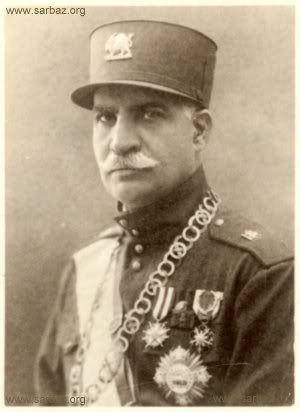
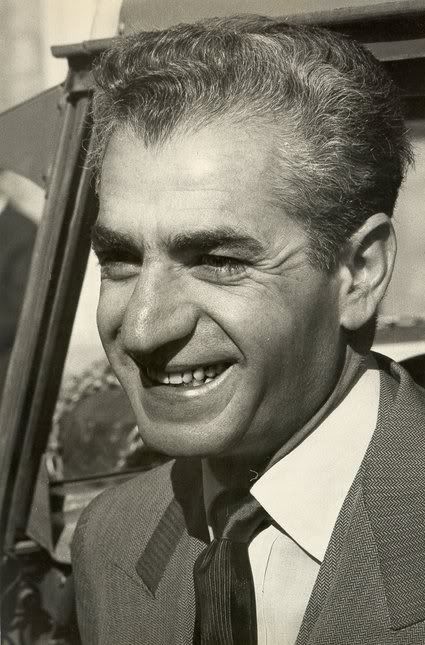
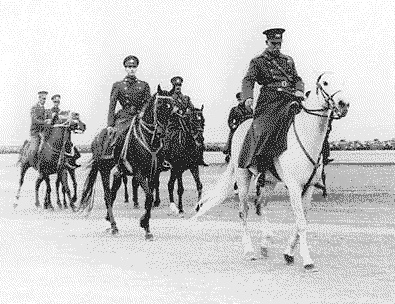
July 26 & 27 marks the passing away of the two Great Pahlavi King's of Iran - Reza Shah the Great and Mohammad Reza Shah (Shahanshah Aryamehr). As I have already written an entry which covered many (although not all) of Shahanshah Aryamehr's achievements I would like to focus this entry more on the founder of modern Iran - HIM Reza Shah the Great.
Iran before Reza Shah the Great was a an impoverished, disease-stricken, bandit-ridden, land with society being controlled by the poisonous grip of the Arabo-Muslim clergy. The ruling dynasty was the Qajar (Kadjar) who where known for spending more time and money travelling abroad than actually being present in the country they ruled. The Qajar's have gone down in Iranian history as one of the worst and most incompetent dynasties to rule Iran due to their complete incompetency and failure in defending Iran's borders with the entire northern parts of the country having been conceded to foreign nations. The Qajar's did not care for Iran as much as they cared for their harem's and trips abroad which had led to a disastrous socio-economic state in the country - the majority of people during the Qajar Era did not even know about their Great historical figures like Cyrus the Great, instead they had been fed Arabo-Muslim propaganda for 1400 years which had made them loose touch with their roots and Iranian identities. Not being able to tolerate the status quo and the threat which foreign powers posed to the integrity of the nation any longer (in particular the threat posed by the Bolsheviks and the Imperialist threat of Britain) a saviour rose up amongst the ranks of the Iranian Cossack Brigade - a man who would become Commander of the Imperial Armed Forces and Minister of War.
Reza Shah went on to quell all unrest across the nation in particular those separatist ambitions which the Soviets had nurtured in the northern provinces (Azerbaijan and Kordestan) and also in the south in Khuzestan were an Arab Sheikh had tried to claim Iranian territory for being Arab land. Reza Shah dealt with these enemies with an iron fist to secure the territorial integrity of Iran. Order had been established in a country which had been lawless for centuries. Having proven his worth and loyalty to his nation the Iranian parliament declared Reza Shah the new King of Iran - and thus the Pahlavi Dynasty replaced the now defunct Qajar Dynasty.
Reza Shah would come to be known as the man who laid the foundation for modern Iran - he set out rebuilding, modernizing, reforming, and improving the peoples' quality of life. Apart from the few accomplishments listed already Reza Shah is credited for:
- Building the trans-Iranian railway
- Introduction of modern education after 1400 years of the Arabo-Muslim clergy having a stranglehold on the Iranian populace through religious brainwashing/indoctrination schools
- Establishment of modern Iran's first University with many more following suit
- Introducing government sponsorship for many Iranian students at foreign educational establishments in Europe and America
- Restricting the rule and power of the Arabo-Muslim clergy
- Emancipation of Iranian women from the imposed Arabo-Muslim all-enveloping dress (chador)
- Judicial reform
- Social and Economic progress
- Introduction of reformed financial and administrative systems
- Reform of the Imperial Iranian Navy and Army
- Creation of the Imperial Iranian Air Force
- Recognizing and respecting Iranian religious minorities who had been oppressed and neglected by the occupying Arabo-Muslim clergy
- Cancelling agreements which worked against Iranian interests that had been signed before his coming to power
- Construction of roads, schools, hospitals
- Nationalization of several economic sectors
For more discussion on Reza Shah the Great's discussion please see THIS OLD THREAD of mine which I started on a discussion forum. Also see THIS PAGE.
See my photobucket album of Reza Shah the Great by CLICKING HERE and of Shahanshah Aryamehr by CLICKING HERE.

UPDATE #1 : Listen to Banoo Pari Saffari's message on the occasions of the Pahlavi Kings' memorial day - CLICK HERE.

